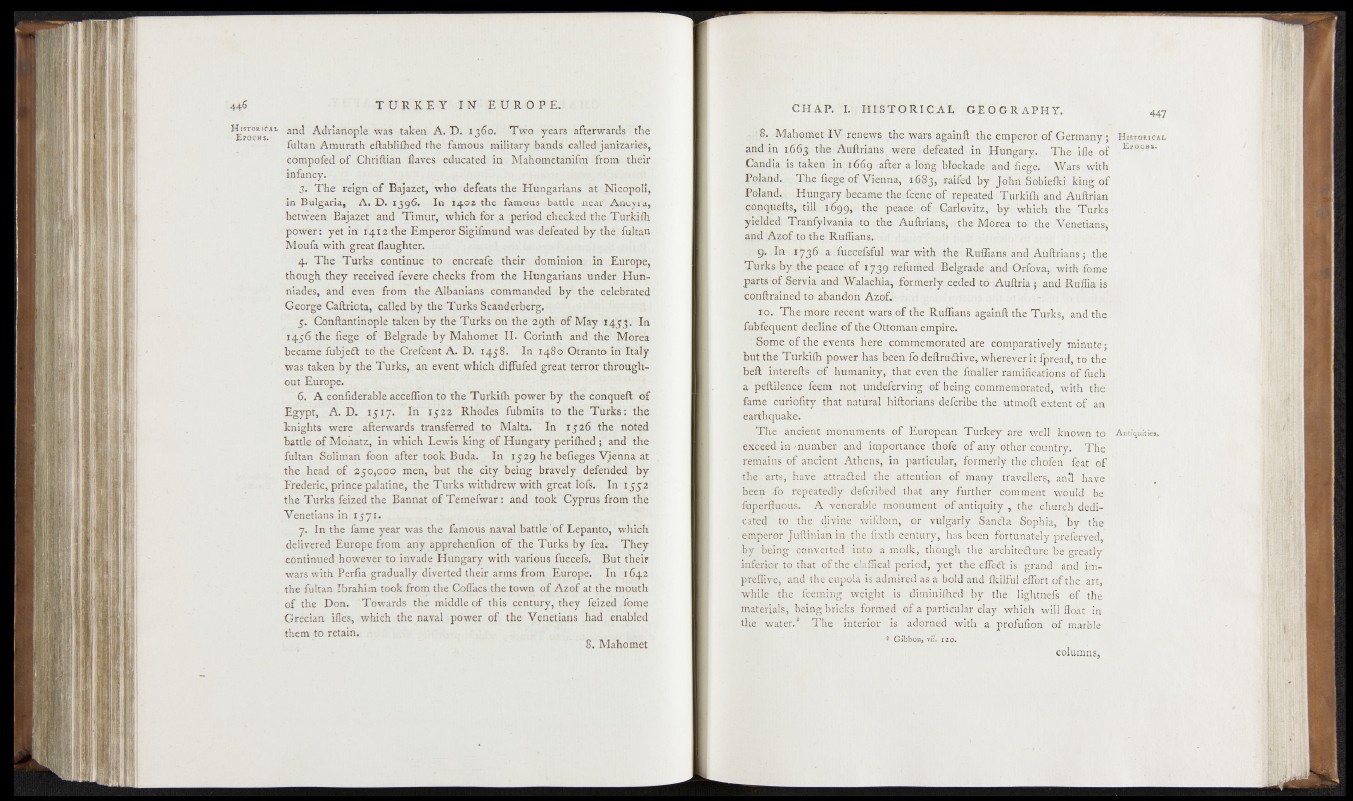
^ an^ Adrianople Wa's taken A. D. 136©. Tw o years afterwards " tie
fultan Amurath eftablifhed thepfaûiôûs military bands eafl3ëd.; j aniz,arièë,
coropofed-bf .Chriftian flaves educated* in Mahometanism’ffroraL the ir
infancy.
■»’: §& T h e reign o f Bajazet, who defeats, t h e . H ungarians àt< ■ l^ieopbli,
in Bulgaria, A. D. 1396. In ' 1402 th e 'f am o u s battle n e ar Ancyra,
between Bajazet and T im u r, which for .a period:checked the T u rk ilh
p ow e r: y e t in 1412 the Em peror Sigifmund wasd e fe a ted b y >th e .fu lta n
Moufa 'with great flaughter. i
4. T h e T u rk s continue to-, encrèafè vtheic dominion: ill Europe,
though they received fevere checks from th e Hungarians- u n d e r H u n -
niades, and even from th e Albanians commanded byl th e {celebrated
George Caftriota, called by th e T u r k s Seahdërberg.
3 . Gonllantinople taken by th e T u rk s on thé Uijffr o f May 1453. In
1436 the liege o f Belgrade b y Mahomet IB 'Cbrinth and the Morek
. betaine fü b jë â to thé Gfëffieût A. D. 1458. I n 1480' O lrim to in Ita ly
was taken b y the. T u rk s, _ am event"which diffufed great te r ro r th ro u g h o
u tE u ro p e .
6. A confiderable acceffion.to the T u rk ilh p ower b y th e conqueft; d f
E g y p t, A. D. 1517. In 1522 Rhodes; fuhmits f o t h e Turks : th e
knights were afterwards transferred to Malta. In .1526 jthe noted
battle o f M ohatz, in which Lewis k in g o f H u n g a ry périfhëd £ and'“ the
fultan Soliman loon after took Buda. In ^529 he.befr^gjes V ien n a,a t
th e head o f 2 5 0 ^ 9 0 men, but th e c ity -b e in g b ^ ê l y '.defended -Ey
Frederic, prince palatine, the Turks withdrew with great Ibfsr In 1552
the Tu rk s fetzed th e Bannat o f T em e fw a r; and took ' Cyprus from the
Venetians, in 1571.
7; In the fame year was th e famous naval battle o f L çpahto, which
delivered Europe from any apprehenfion o f the Turks b y fea.“ ' 'Ehey
continued however to invade H u n g a ry with yarious fuccefs. .But th e ir
Wars w ith Perfiâ gradually diverted the ir arms from Europe. In 1542
the fultan Ibrahim took from the Coflacs th e town o f A z o f at the m çu th
o f the D on. "Towards the middle o f th is century, they fe,ized florae
G re c ian ifles, which the naval power o f th e Venetians had enabled
them to retain.
8. Mahomet
orl®*, 'M^h t ;I Vi yen ^ejWars'iagaihfr'jthutf^pef^ of'Germany; H ISTORICAL
a n ^ .in ^U 'A b fr ria h s tABfer4>’d!efea^d-;f.in LJpmgafyp T h e ifle of
Qaj}diarrs'%ke»hinpf ^ 9 -jailer Masfeade^ajnd -k^ge, t Wars with
fre’ge* of,Vienna, fsphp, Sobfelki king, o f
Pdlandj. H u n g |iiy tK e c ab te jth ey flh ^ b f repeated? tTbirkifh’ and Auftrian
th e !pskdewofs*.^arlp>itz,'r'byPvsbij:h (tih-e' T u rk s-
yj®lfctedp Tfiatifyll^nft'ajatceithe A-u&riaris^wthftrMdreatiybl t'he’fVenetiiaESy
and'’Azo£“to ^tjhe Ruffian®*-in I
< 9. .In j s ^ ^ a i f u ^ a e ^ A lq w ^ r with Kfep:Ruffiatts«amd: Atiffrian-s; the
T u rk s Lyfsthe p e a c d o f ^ ^ t rdfuriied,,Belgrade1 an<fepeTojri,y y d tb iom e
pa-rtg q£ fadtvia! an d WlalacMafTormfirlyiddfed'.tbqAigftri^liand Rbffia is
ccS^rhinfffttb abandon Azof}; u
T h e more recent wars, o f the Ruffians ^ a i n $ tTic Turk«* arid th e » ?
ftlbfequerit' decline o f the Ottoman Sf^>ksje£‘^
'"Some b f th e eyents.<he|ie i&qmmemorated are Ipm p a ra tly e ly ,m in u te j
h u t th e Turkifh «power hasjbeen^fbdeft^udfive, wh^revfeyiiKfnread‘,.td1'the"4' «
,beft interefts "of humanity," th a t ettemtbe- Jin dlcr lUmilKatioiw o f fuch 1m
a . p ^r|IMe|.fe'em- n o t| m*lefervirig( o f bcipg commanmSiaL'. with th e ■'
feme .cMiffity t-hat?'h^tural hiftorians* deleribe the utmoll exterit of! an- '
earthquake'.'
'T h e ancient monuments o f E u ro p ean T u s t e ^ ^ ^ b i r ‘known, to * Auti’qultks.
exceed in > number and im p o te n c e •-thofe'fi-tj|':an^'©ther(ccfunlry.||prhe
remains o f abctenU Athens, in, particular,:'former 1 y the chi>fdh' ifeakVoifi*!
the arts, have -atria dbed th e , a tte b& ln ; o f hr%ny travehef^, arid have’
been .fo repeatedly -d^c ribed that an y fu rther^ doiii-ment would h 'e
fuperfluous. A venerable 'mojUnm eht-;o f ’a n tiq u ity k ’t ^ ^ lchurclf'Sedi^
cated rto the divine 'w i0 om ,!' ^ vulgaily*'Saftelti’ Soph 11 /' hwVtlie ■
emperor Juftinian ib; th e fixthi-century, has been fortunately p n fer\ed, ^
by being converted into, a molk, though the- architecture be greatly
inferior to that of the claffical period, ye t the effedt is grand and im-
preffive, and the cupola is admired as a bold and fkilful effort of the art,
while the feeming weight is diminifhed by the lightnefs o f the
materials, being bricks formed o f a particular clay which will float in ..
the" water.* T h e interior is * adorned with a prqfufioh;.\ef marble
120. .■
columns.